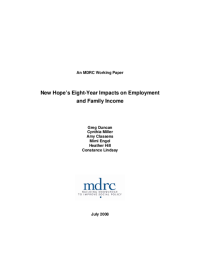New Hope’s Eight-Year Impacts on Employment and Family Income
Conceived of in the late 1980s and implemented in 1994 in two inner-city areas in Milwaukee, Wisconsin, New Hope was an innovative program designed to address problems in the low-wage labor market. New Hope provided full-time workers with several benefits: an earnings supplement to raise their income above poverty, low-cost health insurance, and subsidized child care. For those unable to find full-time work, the program offered help in finding a job and referral to a wage-paying community service job when necessary. During the demonstration project, each of these benefits was available for up to three years.
This working paper takes a longer-run look at New Hope’s impacts on employment and earnings, as well as on family income and poverty, up to eight years beyond the point of random assignment. The findings show that the program’s effects on poverty that were evident at year five for the full sample did not persist to year eight. However, effects on employment and earnings for a moderately disadvantaged group remained large and statistically significant through year eight.






